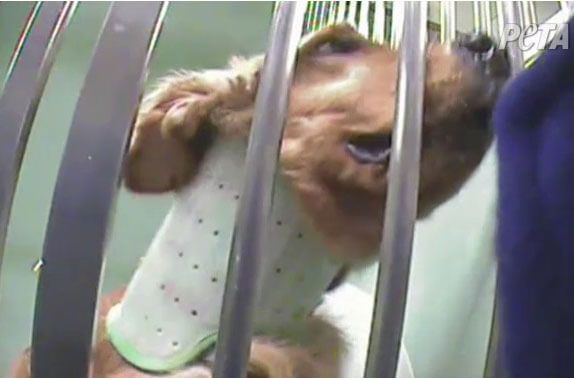Behind the Locked Doors of U.S. and French Dog Laboratories
Update (November 4, 2022): Victory! Texas A&M University has confirmed that it will release the nine healthy golden retrievers it had betrayed by transferring them from its notorious canine muscular dystrophy laboratory to the veterinary school. This momentous news comes after PETA’s hard-fought campaign that began with our shocking exposé of the school’s horrendous laboratory. Our relentless pressure ended its cruel breeding of dogs to develop this crippling disease and led to the release of more than 50 canines. Now these nine dogs will be in loving homes by the end of the year.
Video footage obtained by PETA reveals that behind closed doors at Texas A&M University (TAMU), dogs deliberately bred to develop crippling muscle diseases struggled to walk and swallow. Experimenters at the University of North Carolina at Chapel Hill and the University of Missouri also engage in this shameful practice in which colonies of dogs are bred to suffer from progressive muscular degeneration. Video footage given to PETA France by the group Animal Testing shows that the same misery is being endured by dogs at France’s Alfort National Veterinary School.

Misery in Texas
At Texas A&M University, experimenters, led by Joe Kornegay, breed dogs to develop different types of muscular dystrophy (MD), including Duchenne muscular dystrophy (DMD), which is particularly severe. These diseases ravage their bodies, causing progressive muscle wasting and weakness. Studies with these dogs haven’t led to a cure or even a treatment to reverse disease symptoms.
Video footage shows that Kornegay’s appallingly thin dogs were caged, sometimes alone, in barren metal cells and struggled to swallow thin gruel—the only food that they could eat, given how easily they could choke. Long ropes of saliva hung from the mouths of dogs whose jaw muscles had weakened. Even balancing was difficult. Dogs with this condition are also at great risk for pneumonia because they can easily inhale liquid into their lungs.
Dogs who didn’t have the disease but carried the DMD gene were used for breeding. Deprived of loving homes, they frantically paced the slatted floors and bit the bars of small cages in frustration. They didn’t even have the comfort of a blanket.
To gauge just how much a dog’s muscles have deteriorated, Kornegay has invented a crude technique that could pass for medieval torture: He repeatedly stretches them with a motorized lever in order to cause muscle tears.
Kornegay has been at this for more than 35 years. (Experts refute his claims about his work and what the dogs in his experiments endure.) Puppies in his laboratory who are born with DMD are so weak at birth that they require extra nutrition. By 6 weeks of age, their hind limbs have shifted forward, making walking difficult, and some are unable to open their mouths or jaws. (Read all the expert statements on the ethics and scientific validity of Kornegay’s work.)






Breeding Pain and Misery in a French Laboratory
The dogs are genetically prone to different types of muscular dystrophy (MD), including Duchenne muscular dystrophy (DMD), which is particularly severe. (FAQ on MD experiments using dogs) These diseases ravage their bodies and are characterized by progressive muscle wasting and weakness. Most dogs never reach adulthood. Some are completely crippled before they even reach 6 months old, and half endure agonizing deaths before the age of 10 months.
The heartbreaking video footage shot inside a laboratory in Alfort shows dogs having difficulty swallowing, breathing, and walking as their muscles continue to waste away.
Some dogs eventually lose their ability to eat and must then be fed through a stomach tube. Surviving dogs will develop heart problems as the disease attacks and weakens the cardiac muscle.
A laboratory employee admitted that these dogs suffer. He said,
“I wouldn’t like to be in the beagle’s place. The suffering is real.”







Bad Science
What have these painful experiments accomplished?
After decades of testing on generations of debilitated and suffering dogs, there is still no cure or treatment to reverse the course of this terrible disease in humans. So children afflicted with DMD continue to suffer. Analysis of muscular dystrophy studies using dogs has shown that there are serious pitfalls when trying to apply those results to humans. In fact, there are even studies that have produced the opposite results in humans. There are better ways to help patients with MD.
Cutting-edge techniques, some employing the gene-editing tool known as CRISPR, will lead to the development of more promising therapies. Forward-thinking scientists are using cells from DMD patients to develop disease-specific cures, developing ways to grow healthy human muscle cells that could be transplanted into patients with MD, creating human-relevant drug-screening platforms, and using other human-based analyses and computational methods.

This 6-year-old golden retriever, known as Jelly, shown here in an article about Kornegay’s experiments, suffered damaged ligaments and weakened muscles after DEVELOPING MUSCULAR DYSTROPHY. KORNEGAY USED THIS AND OTHER DOGS TO SEARCH FOR PHARMACOLOGIC THERAPIES FOR THE DISEASE – an effort that has failed so far.
Téléthon: Helping or Hurting?
The experiments at Alfort National Veterinary School are funded by the French charity AFM-Téléthon. However, a laboratory official admits that the laboratory could lose that funding if the public were to see the condition of the dogs.
“There’s no question that if we showed them our myopathic dogs, they would risk losing a lot of money.”
As well they should.
